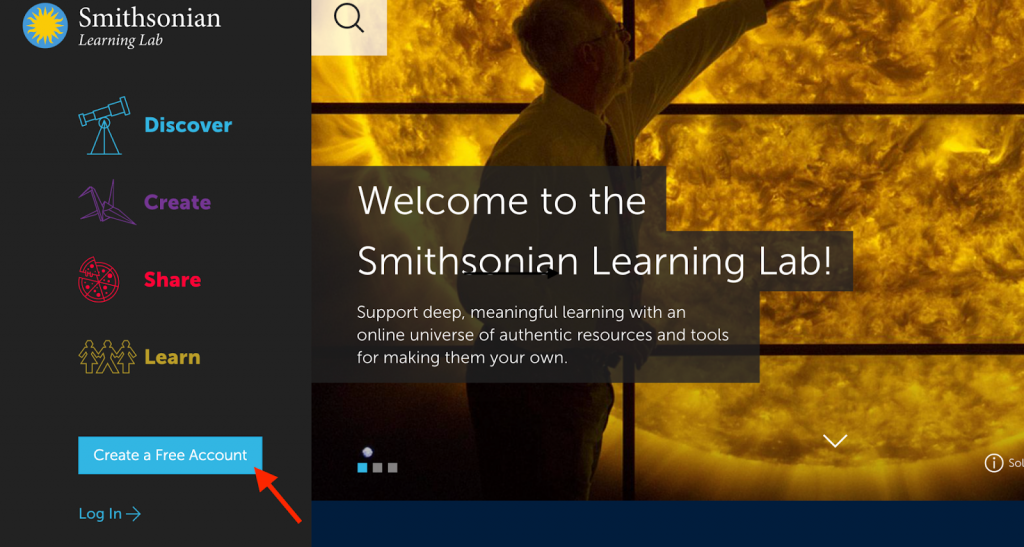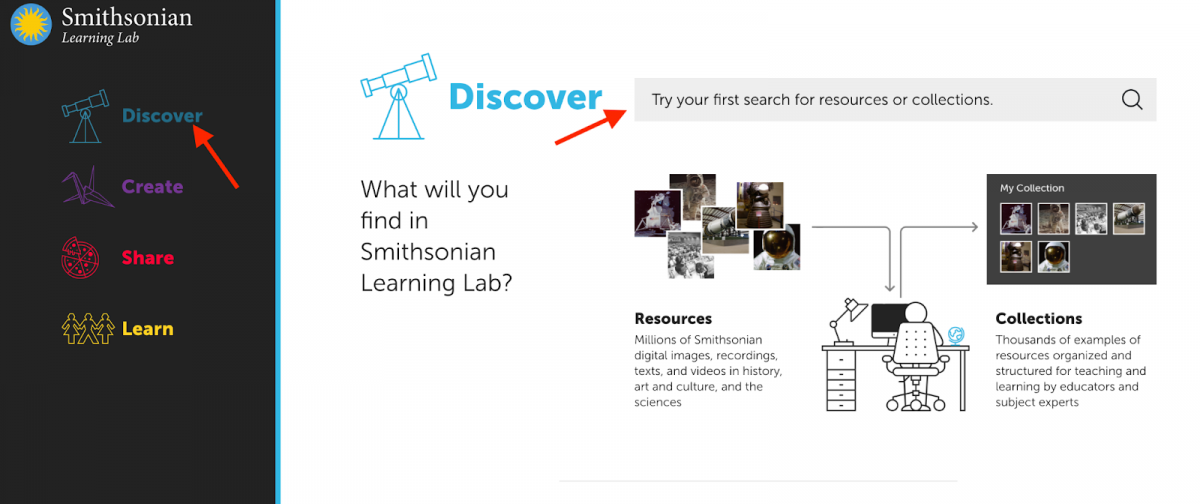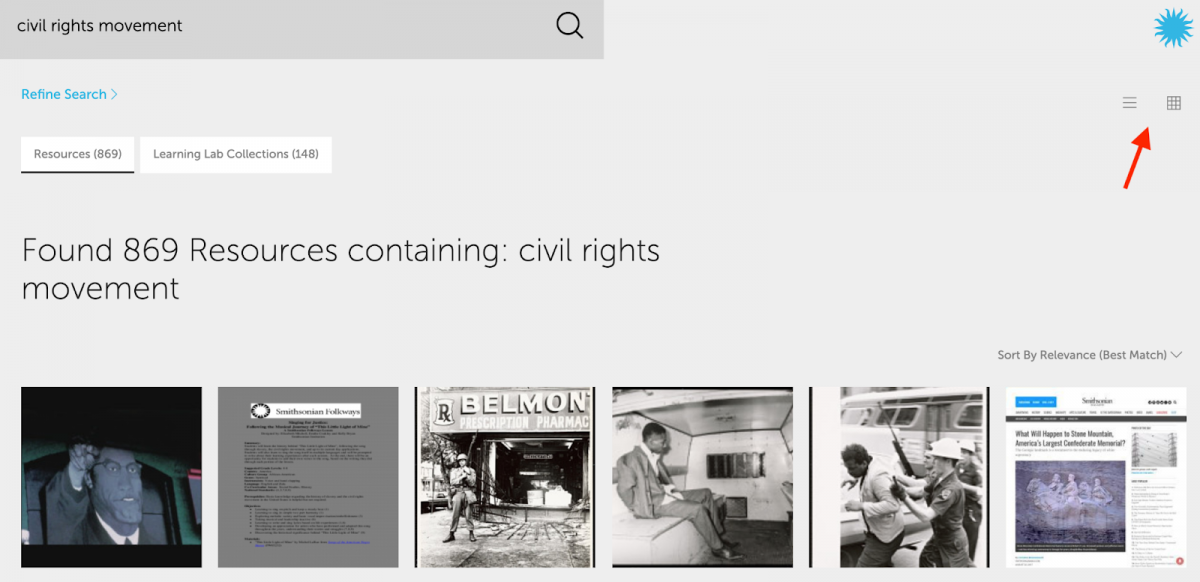The Smithsonian Learning Lab is a collaborative web-based learning platform that features videos, audio files, texts, and historical artifacts from the Smithsonian’s 19 museums, 9 research centers, and zoo. Created by the Smithsonian Center for Learning and Digital Access, the Smithsonian Learning Lab is meant to be a resource that inspires educators, youth, and the public to explore the Smithsonian’s digitally archived content. Users can create “collections” of materials on specific topics, share their collections, and add to other users’ collections as well. There are millions of texts, recordings, artifacts, and videos accessible through the Smithsonian Learning Lab, and accessing these digital materials is made simple through a search using keywords or phrases relevant to a topic of interest. The Smithsonian Learning Lab allows students to think and explore like a historian, organize collections like a museum curator, and even draw connections between history and any subject they are studying.

 Watch on YouTube
Watch on YouTubeWatch on YouTube https://edtechbooks.org/-QYXA
Why Use the Smithsonian Learning Lab Video (by Smithsonian Education)
Tool Snapshot
Ease of Use
The site earns 4 out of 5 stars for its ease of use. This tool is easy to figure out and there are two instructional videos on how and why to use the Learning Lab on the homepage. Simply using the navigation bar to search for content will bring the user to the resources they are looking for as well.
Privacy
This tool earns 4 out of 5 stars for privacy, because while their policies are comprehensive, they still collect some data from their users. Upon creating an account, users are greeted with links to the Smithsonian Institution’s Privacy Statement, as well as the Smithsonian Kids Online Privacy Statement. Both statements outline the protection users are afforded while engaging with this tool. Users are provided with options to opt out of communications or to delete account information at any point and the Smithsonian provides a detailed description of ways user and child data are maintained and used. According to their policies, users will always be notified of changes and updates to existing privacy policies and statements.
COPPA/FERPA Compliant: The Smithsonian Learning Lab pays specific attention to articulating COPPA and FERPA compliance in its general Privacy Statement. The Smithsonian Learning Lab undergoes a yearly certification of compliance by iKeepSafe through the COPPA Safe Harbor Program. The Smithsonian Learning Lab also holds the iKeepSafe FERPA Assessment Badge, which they describe as a badge that indicates to schools and parents that their content is in compliance with FERPA regulations.
Accessibility
This tool only earns 3 of 5 stars for accessibility because the navigation options are somewhat limiting. While users can use keyboard shortcuts to navigate the search bar, selecting content and collections of materials is slightly challenging if a user only has access to a keyboard. Additionally, further research into the tool yielded no published accessibility statement, which may indicate noncompliance with ADA standards, and additional accessibility options remained unclear after testing.
ISTE Standards
Empowered Learner
- Students can customize their learning environment by curating collections of digital artifacts and materials to support their learning.
Knowledge Constructor
- At its core, the Smithsonian Learning Lab is a content curation tool that allows students to construct knowledge by collecting and organizing digital artifacts from the Smithsonian.
- When interacting with the site, intellectual criticality and examining resource diversity are encouraged through exploring examples of others’ collections.
Creative Communicator
- Students can remix digital resources into new creations and collections to express their vision and personality for assignments.
- Students can construct and share their creations through a variety of platforms, tools, and digital media.
4 Reasons to Use the Smithsonian Learning Lab

 Watch on YouTube
Watch on YouTube
The Smithsonian Learning Lab & the SAMR Model
Dr. Ruben Puentedura’s SAMR model offers a lens for examining how technology is adopted in a classroom. Here is an example of how the Smithsonian Learning Lab might fit within the SAMR model:
- Substitution: Students use collections to research and learn more about a specific topic, which substitutes the need for a visit to the library to seek resources.
- Augmentation: Students can explore pre-designed collections by others which might include audio, video, or hyperlinks to further resources.
- Modification: Students have the ability to organize videos, essays, photos, and artwork into a thematic collection of their specific area of interest.
- Redefinition: Students who might not traditionally have access to visit the Smithsonian museums, research centers, or zoo in person can still engage with and access millions of digital materials from these places
Far too often, technology is used as a direct substitute for other low-tech tools (e.g., pencil and paper). While substitution has some benefits (e.g., students develop their technology skills and knowledge), we encourage you to think about how you might use the Smithsonian Learning Lab to modify or redefine learning.
Learning Activities
Science
Students can search the Smithsonian Learning Lab database to see archival materials used in innovative scientific research programs, as well as articles or related resources that help to explain or define a certain scientific concept. For example, if a student is working on a project about space exploration, they could input “space travel” in the discovery search bar, which would present resources and collections of space exploration materials to analyze.
English/Language Arts
Students have the ability to see source documents within the Smithsonian’s collection and can investigate these documents for reading activities. Documents such as field journals, diaries, and letters, as well as biographical information about historic writers and their written works are accessible through the Smithsonian Learning Lab. Students can search as specifically as they like for content that relates to their interests, research, or assignment requirements.
History/Humanities
History and the humanities are interwoven throughout the majority of the content available through the Smithsonian Learning Lab. As is the case with many museums, the content provided by the Smithsonian is an archive of historical documents, materials, artifacts, and information. Students could research The Reconstruction Era to see artifacts and documents that show the complex history of American Democracy.
Other
Students have access to resources available via the entire Smithsonian, providing a myriad of opportunities for learning relevant to historical and archival content. If a topic or idea has been recorded in history, it is highly likely that the Smithsonian Learning Lab can provide access to it and/or related content.
Resources
How to Use the Smithsonian Learning Lab
Users can peruse the “Getting Started Guide” or follow the directions below to begin using the Smithsonian Learning Lab.
- Go to https://learninglab.si.edu.

- Click “Create a Free Account” and sign up for an account.


- Begin using the Learning Lab.
- Click the “discover” icon on the navigation bar to open a search bar to search the Learning Lab’s content.

- Choose grid or list view to scroll through collections of materials on any given subject.

- Select a collection by clicking on it to view or read the content within.

- Click the “Info” icon (blue box with “i” symbol) to find a description of the original source, the material type, the medium, dimensions, and description of the content you are viewing or interacting with.

Research
Milligan, D., Wadman, M., & Ausland, B. (n.d.). Discovering, creating, and sharing digital museum resources: a methodology for understanding the needs and behaviors of student users. MW17.
Rappoport, P., & Liguori, A. (2019). Digital Storytelling in cultural and heritage education. Reflecting on storytelling practices applied at the Smithsonian center for learning and digital access to enhance 21st century learning. Andreas Moutsios-Rentzos, 63.
Zinger, D., Naranjo, A., Amador, I., Gilbertson, N., & Warschauer, M. (2017). A design-based research approach to improving professional development and teacher knowledge: The case of the Smithsonian learning lab. Contemporary Issues in Technology and Teacher Education, 17(3), 388-410.
Authors
This page was created by Sam Torres.